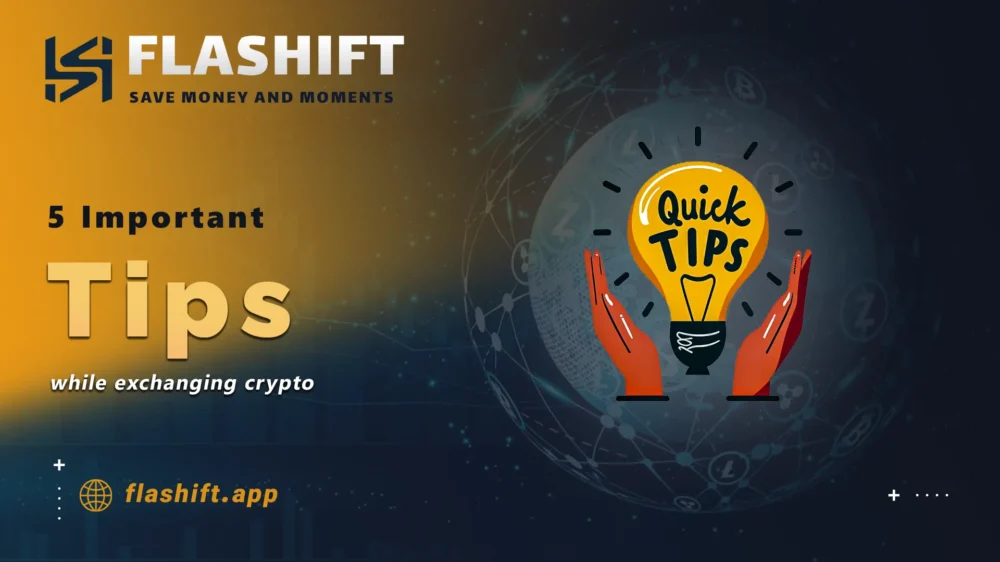5 Important Tips to Exchange Crypto: Trading cryptocurrencies is exciting and somewhat intimidating both for the new and more seasoned investor. With the ongoing growth in the digital asset market, learning how to make exchanges work for them properly will mean the difference in better profits and less exposure to risk. Whether trading Bitcoin for Ethereum, investing in emerging altcoins, or converting crypto to fiat currency, there are numerous important considerations to keep in mind. Timing and strategy play a huge difference in crypto market volatility. Besides, with ever-changing regulations and possible security risks looming, it becomes pertinent to approach it with caution and knowledge.
What Is Crypto Exchanging?
Buying and selling in cryptocurrencies is the art of cryptocurrency exchanging, available through diverse multiple cryptocurrency exchanges. Exchanges are like middlemen between two, whereby one can either buy or sell the digital assets between buyers and sellers in the cryptocurrency ecosystem. Some of the many types of cryptocurrencies in existence today, a number of exchanges enable trading among a variety of digital assets-from the popular choices like Bitcoin and Ethereum to a host of altcoins.
Nowadays, there are mainly two huge types of cryptocurrency exchanges: centralized and decentralized. Centralized exchanges, like Binance, Coinbase, and Kraken, actually work pretty much in the middle-man manner, matching buyers to sellers and offering ease-of-use interfaces, liquidity, and customer support. Most often, users must create accounts and pass verification processes. Such sites are popular due to their ease of use but involve certain risks and are under noticeable scrutiny from regulators.
While decentralized exchanges rely on blockchain and provide direct trading among their users without any intermediary, for example, such blockchain platforms as Uniswap and Sushiswap enable one to trade directly with the peer, thus allowing for more privacy and control over one’s funds. Yet, DEXs are less user-friendly to work with and bear specific risks related to the vulnerabilities of smart contracts.
There is so much to cryptocurrency trading, like trading fees, limits on withdrawals, or even the assets supported. With regards to the crypto market, for example, price volatility might fluctuate from extremely high to extremely low; timing, then, becomes one of the most important elements. More to the point, understanding what is meant by trading pairs and market order entails knowledge of what currency is being traded while buying or selling an asset at the prevailing price.
It also allows for cryptocurrency exchanging to serve as the primary avenue of entry through which people are trying to join this burgeoned digital asset market. If opted correctly, along with strategies that work in favor of the users, it enables them to get around the complications of crypto exchanging and make good use of some of the opportunities for investment.
Important Tips to Exchange Crypto
Below are five essential tips that will be of immense help if you’re set on how to exchange cryptocurrencies safely and effectively. The tips range from choosing a good exchange and understanding market trends to managing fees. This will help you go a long way in improving your trading experience, securing your investments, and confidently handling the complexities involved in the crypto market. Whether you are a complete beginner wanting to make your very first trade or an established trader looking to fine-tune your strategy, these tips will be useful tools in your cryptocurrency journey.
-
Check the Destination Network
While seemingly trivial, meticulously verifying the network before token dissemination is paramount. Each blockchain network boasts unique prerequisites and attributes. Regrettably, the accidental transmission of tokens to an erroneous blockchain, such as mistakenly routing ERC-20 tokens from Ethereum to BNB Chain, remains a plausible misstep. This oversight can lead to the irretrievable loss of assets, underscoring the critical importance of ensuring accurate network identification and adherence to specific blockchain protocols prior to executing any transactions.
Consequently, such an error could precipitate transactional disruptions and refund complications. Therefore, exercising prudence dictates a brief pause for network validation before initiating transfers. This rudimentary measure serves as a bulwark against potential entanglements, facilitating the seamless journey of your tokens to their intended destination, thereby streamlining operations for both yourself and the support apparatus.
-
Keep in mind the difference between floating and fixed rates
Let us elucidate the disparity between floating and fixed rates in layperson’s terms. A fixed-rate crypto exchange entails trading your cryptocurrency at a predetermined rate established at the outset, irrespective of subsequent fluctuations. Opting for fixed-rate offers ensures a secure swap, guaranteeing the anticipated amount.
Nevertheless, fixed rates are not without exceptions. Significant fluctuations in the overall token value may prompt exchange cancellations or rate adjustments. Fortunately, instant exchanges typically provide clarification before the exchange occurs. Alternatively, when depositing funds, particularly in fixed-rate scenarios, expedited processing is crucial to ensure timely receipt by the instant exchange—typically within 20-30 minutes—to avoid potential complications due to network congestion.
Conversely, floating rates, though potentially offering higher returns, entail inherent risks. Pursuing the best rate necessitates assuming certain risks, as floating rates can prove highly unpredictable. Therefore, for those prioritizing stability and certainty, adhering to fixed rates offers a prudent course of action, safeguarding against unforeseen surprises.
-
Hold the Network’s Native Token to Pay Gas-Fee
To execute transactions on specific blockchains such as Ethereum (for ERC-20 tokens), Binance Smart Chain (for BEP-20 tokens), or Polygon (for MRC-20 tokens), possession of their specific native tokens within your wallet is imperative. For instance, when initiating the transfer of ERC-20 tokens, a requisite amount of ETH (Ethereum’s native token) must reside in your wallet to facilitate the payment of transaction fees, colloquially referred to as “gas.”
Similarly, for BEP-20 tokens on Binance Smart Chain and Polygon, possessing BNB (Binance Coin) and Matic tokens, respectively, is mandatory to offset network fees. Equipped with these native tokens, you ensure seamless transaction processing across their respective blockchain networks, facilitating unhindered transactional flow.
-
Consider the Commission’s Details
When utilizing an exchange or wallet, the transparency regarding whether the network fee is included in the amount you send can often be murky. These fees are sometimes deducted inconspicuously, necessitating vigilant attention to commission details. For instance, envision attempting to exchange 100 LTC to ETH, only to discover that the instant exchange receives a deposit of 99.1 LTC, with 0.9 LTC designated for network fees. Failure to scrutinize commission particulars can significantly impact the instant exchange rate.
It behooves one to thoroughly examine and comprehend how commissions operate on the exchange platform being utilized. Doing so will mitigate the risk of unwelcome surprises and ensure the receipt of the correct amount in return for your transactions.
-
Don’t Forget Memo
Before cementing a transaction within a digital currency, it’s prudent to ascertain whether a “memo” section exists. Think of it as a note affixed to your transaction, allowing you to append additional information or details. Typically, the platform or blockchain being utilized supports memo functionality.
Sometimes, memos are imperative for instant exchanges or exchanges to identify the transaction accurately. Therefore, before committing to the final step, take a moment to ascertain the availability of a memo option. This simple precaution ensures that your transaction is correctly identified and processed.
The Bottom Line
Embarking on the voyage through the labyrinthine world of crypto exchanges need not be daunting, provided one wields a few indispensable insights. From discerning the correct network for seamless token transfers to grasping the nuances between fixed and floating rates, these nuggets of wisdom are tailored to elevate your exchange experience.
Maintaining a reserve of native tokens to cover gas fees, exercising diligence in commission scrutiny, and verifying the presence of memos all serve to fortify your crypto journey with knowledge and security.
By incorporating these straightforward practices into your routine, you can streamline your cryptocurrency exchanges, ensuring efficiency and safeguarding your transactions. With Flashift at your disposal, you possess a versatile tool capable of facilitating most instant exchanges, empowering you to navigate the exchange landscape easily and precisely, tailored to your preferences.






